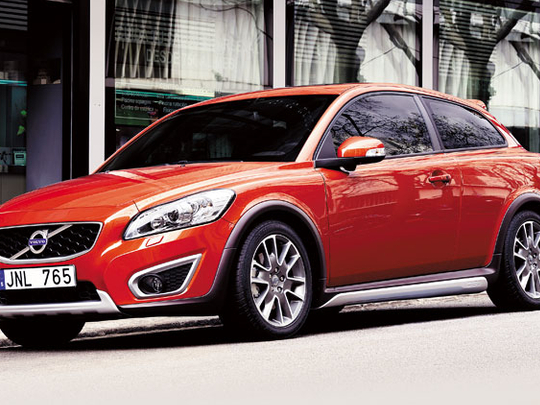
"I'm not really an aggressive driver," I tell my slightly bewildered passenger, as I brake hard into one of an endless number of switchbacks midway up Lebanon's snow-capped Kfardebian-Mzaar mountain range. Yet again, another sporty car has made a hypocrite out of this safety conscious driver.
I'm a repeat Volvo customer, having cut my teeth on an old 240 DL estate, the speed of which was inversely proportional to its stellar safety rating, and I don't really consider myself an acceleration addict. After my first Volvo I had yet another 240 DL estate, and finally a very nice 940 saloon, which was the last model to feature Volvo's original indestructible four-cylinder engine, and body-on-frame design. Given my long romance with the brand's historic line-up of rather heavy, small-engined cars, I found it odd to have my tortoise-like soul tweaked by the new R-Design C30.
The way I was driving might be considered mild by Dubai standards, but the car handled well enough that I was met by the acrid smell of freshly burnt brake pads each time our convoy of journos stopped to pick breakfast crumbs out of our reindeer themed jumpers. Volvo may have changed tact long ago, when the brand transitioned towards a more upscale aesthetic and introduced its first five-cylinder engine in the late Nineties, but consider me late to the party.
A little history is in order here. First, let's recall that Volvo invented the seat belt, or at least redefined it in a way that has gone on to save numerous lives. What Nils Bohlin, chief safety engineer for Volvo Car Corporation actually invented was the modern three-point safety belt. Mr Bohlin had spent much of the Fifties designing ejector seats for the Swedish aviation industry and had noticed that, two-point safety belts similar to those in the centre rear seat of many saloons, which were typical in aviation, tended to cause severe abdominal injury in high-speed collisions. It remains unclear why the entire ejector-seat concept was never implemented at Volvo, but the three-point safety belt eventually became the international standard for passenger cars, and Volvo reckons that the seat belt has saved more than one million lives in the last 40 years.
I certainly had my seat belt on as I accelerated into another limestone rimmed straightaway, the C30's 230bhp T5 engine pulling the diminutive Volvo forward in a pleasingly muscular manner.
The R-Design C30 feels lightweight and ready to go. It accelerates nicely and doesn't lack torque out of the gate like the more laden Volvos of the distant past. Cornering also feels fairly tight, and although this model does not feature Volvo's AWD package, the car feels fairly well glued to the road. If I were staging a hatchback shootout, I'd love to put the C30 up against the Audi A3 and the BMW 1 Series because, although it may be a tad less luxurious than the others, the C30 is surprisingly fun to drive and I suspect it could hold its head high in Teutonic company.
This latest C30 edition isn't quite all new though, but since I'd only sat behind the wheel of the previous year's model rather briefly, it felt new to me. The R-Design package features a fresh bodykit with front and rear spoilers, lower door trim moulding and side skirts colour-matched to the rest of the body, 17in five-spoke Cratus aluminium wheels (18in optional), a tailgate spoiler, visible chrome-plated sports tail pipes, and an R-Design badge that, along with many other features, announces that this is a particularlysporty Volvo.
In some ways the C30 R-Design may be the boldest pony in the Volvo stable, and the large rear windshield is a clear homage to Volvo's iconic P1800 ES, a Karmann Ghia-like sports estate that is largely lost to history despite its bold design. Like the P1800 in its various guises, the C30 offers a love it or hate it design proposition, and this writer is a lover, not a fighter. Looking at the front end of the car, it conforms fairly closely to the rounded, slightly pinched face that has said, "here comes a Volvo" since the S series was introduced in 1996. True, the Sisyphean pursuit of modernity has smoothed and rounded the appearance of the cars over the years, but it's really the backside of the C30 that makes it the most radical design departure that Volvo has made in quite some time.
Over the course of the day, I drove a number of redesigned, top trim level Volvo models, and one unifying theme is that the interiors have come a long way since my 1982. In fact, styling has come a long way since the 2001 S40 that I had on loan a few months back. The first thing you notice when you sit in the car is the slender data input column at the centre of the dashboard. Integrated in the control panel is a telephone style keypad that functions with your mobile phone via Bluetooth. The premium sound system comes with both USB and 1/8in analog inputs, so your iPod should pair up with it in a relatively painless manner.
The leather seats and detailing are very nice, but of a slightly more utilitarian strain that you'd find in a German luxury vehicle. Which isn't to say that the Volvo isn't luxurious per se, just that it's neither as ostentatious as some of its European competitors, or as pedestrian as some Asian models. But then again, that may be part of its appeal.
Specs & rating
Model C30 T5 R-Design
Engine 2.5-litre turbo five Transmission Five-speed auto FWD
Max power 230bhp @ 5,000rpm
Max torque 320Nm @ 1,500rpm
Top speed 234kph
0-100kph 7.1sec
Price Dh130,000
Plus Quick, agile, good looking
Minus Ugly dashboard, poor visibility











